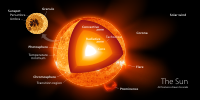
Photo from wikipedia
Based on MaNGA integral field unit (IFU) spectroscopy we search 60 AGN candidates, which have stellar masses M? 6 5 × 10M and show AGN ionization signatures in the BPT… Click to show full abstract
Based on MaNGA integral field unit (IFU) spectroscopy we search 60 AGN candidates, which have stellar masses M? 6 5 × 10M and show AGN ionization signatures in the BPT diagram. For these AGN candidates, we derive the spatially resolved stellar population with the stellar population synthesis code STARLIGHT and measure the gradients of the mean stellar age and metallicity. We find that the gradients of mean stellar age (metallicity) of individual AGN-host dwarfs are diverse in 0−0.5 Re, 0.5−1 Re and 0−1 Re. However, the overall behavior of the mean stellar age (metallicity) profiles tend to be flat, as the median values of the gradients are close to zero. We further study the overall behavior of the mean stellar age (metallicity) by plotting the co-added radial profiles for the AGN sample and compare with a control sample with similar stellar mass. We find that the median values of light-weighted mean stellar ages of AGN sample are as old as 2−3 Gyr within 2 Re,which are about 4−7 times older than those of the control sample. Meanwhile, most of the AGN candidates are low-level AGNs, as only eight sources have L[O III]>10 erg s−1. Hence, the AGNs in dwarf galaxies might accelerate the evolution of galaxies by accelerating the consumption of the gas, resulting in an overall quenching of the dwarf galaxies, and the AGNs also become weak due to the lack of gas. The median values of mass-weighted mean stellar age of both samples within 2 Re are similar and as old as about 10 Gyr, indicating that the stellar mass is mainly contributed by old stellar populations. The gradients of co-added mean stellar metallicity for both samples tend to be negative but close to zero, and the similar mean stellar metallicity profiles for both samples indicate that the chemical evolution of the host galaxy is not strongly influenced by the AGN.
Journal Title: Research in Astronomy and Astrophysics
Year Published: 2021
Link to full text (if available)
Share on Social Media: Sign Up to like & get
recommendations!